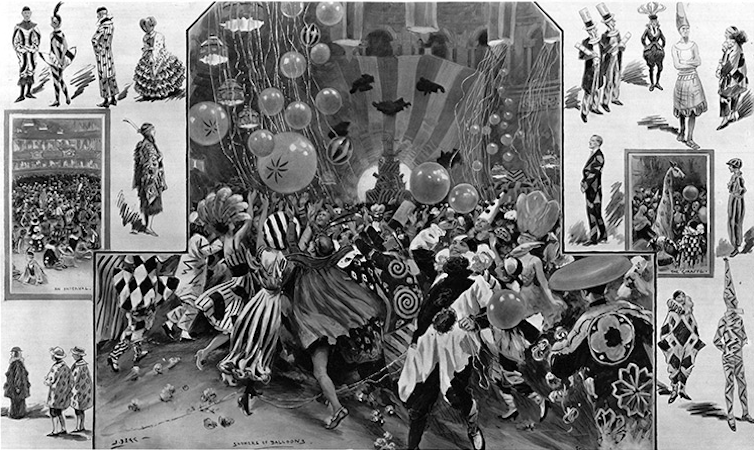Five Christmas fashion trends we should bring back – and may be found in your wardrobe already
Christmas is a season for partying and dressing up. Sequins, Santa hats and ugly Christmas jumpers abound. Each event seems to demand a new and different outfit

Estimated reading time: 10 minutes
Bethan Bide, University of Leeds
While this clothes buying bonanza may boost fashion retail profits, it also leads to a vast amount of waste as many items end up in landfill by the new year. For a season so steeped in tradition and nostalgia, this emphasis on new clothes seems out of place.
Instead of buying new outfits each December, research suggests we can both help save the planet and boost our own wellbeing by re-wearing garments and making them part of our Christmas traditions.
If you are stuck for inspiration about how to dress better and more meaningfully this holiday season, here are some of the best festive trends from the history of fashion that are ripe for revival and can be easily found in your wardrobe.
1. The silk Christmas scarf
The 20th century was the golden age of the printed silk scarf. In the 1930s, silk manufacturers, such as British firm Jacqmar, began to produce beautifully designed scarves as a way of marketing their artistic textiles.
During rationing in the second world war the printed propaganda scarf became a must-have fashion accessory that could be used to update an old outfit. From the 1950s onwards, patriotism gave way to novelty prints, including Christmas-themed scarves.
French and Italian luxury brands were particularly good at these, with Hermès leading the way in charming traditional designs and Moschino producing fun and irreverent prints. Silk scarves are free of microplastics and can be used to make an existing outfit instantly festive. Infinitely more chic and sustainable than your polyester Christmas Jumper.
2.Dressing all in green
The mysterious handsome giant from the Arthurian romance Sir Gawain and the Green Knight might seem an unusual source for festive fashion tips, but the Green knight dresses with symbolically loaded style.
When he shows up to King Arthur’s New Year celebrations looking to play a Christmas Game, the Knight is dressed head to toe in emerald green, including matching hood and fur-trimmed mantle. The outfit also includes costly silk in gold and green stripes and decorative embroidery, topped off with a bough of holly.
Academics have published lengthy papers debating exactly what this strange outfit means, but it is undeniably eye catching. Who needs a Christmas tree when you can dress as one? Many of us have green clothing already to put to good festive use.
3.Dazzle fancy dress costumes
Fancy dress parties have their origins in the masquerades that grew around European carnival season in the 15th Century and the historical costume balls of 19th century Britain.
But the most fabulous era of fancy dress occurred in the first decades of the 20th century, culminating with the fabled Chelsea Arts’ Club New Year’s Eve Ball , which ran from 1908 to 1958 in London.
Attendees competed to wear the most novel creations, dressing as everything from mythical sea creatures to art movements. During the first world war, there was a trend for costumes in the abstract patterns of “dazzle” camouflage.
These intersecting geometric patterns in contrasting colours were painted onto ship hulls to make it hard for the enemy to estimate the vessel’s course. The eye-catching designs proved so popular with fancy dress fashionistas that they became the subject of a special “dazzle”-themed Arts Club ball in 1919.
4.Wooden shoes
Wooden clogs have traditionally played an important role in Dutch Christmases, with children leaving them out on 5 December for Sinterklaas (based on Saint Nicholas and also an inspiration for Santa Claus) to fill with treats. In modern times, they could provide a practical answer to keeping your party shoes looking their best for another year.
Wooden clog-like overshoes called pattens were widely worn in Europe from the medieval period to the 19th century to protect thin-soled shoes over the winter season. They were used by pedestrians who walked in streets caked in mud and where food waste and excrement were all deposited.
By the 17th century, their soles were specially shaped so your existing shoes slotted right in. Fancier versions even had luxurious silk straps to match the fabric of the delicate shoes they covered. While these sorts of clogs aren’t common anymore, wooden clogs have become popular (dare I say fashionable) again but tend to only be worn in more temperate weather. You now have an excuse to get them out again this Christmas.
5. Party pyjamas
Christmas is a season for inviting friends and family over, and the hostess pyjama is the perfect outfit in which to receive your guests.
Pyjamas began as a menswear trend in Western fashion when 19th-century British colonial forces took a fancy to the lightweight drawstring trousers worn in India. They made their transition to womenswear in the 1920s as a summer resort fashion in the form of elegant linen beach pyjamas.
Before long, designers such as Coco Chanel were producing versions in velvet, silk and sequins for winter evening-wear. The trend was cemented in the 1930s by leading figures in the fashion world, including Vogue editor Diana Vreeland.
These party pyjamas are the perfect combination of dressy yet comfortable and have room enough to accommodate an extra helping of pudding and should be worn and enjoyed all year round.

Looking for something good? Cut through the noise with a carefully curated selection of the latest releases, live events and exhibitions, straight to your inbox every fortnight, on Fridays. Sign up here.![]()
Bethan Bide, Lecturer in Design and Cultural Theory, University of Leeds
This article is republished from The Conversation under a Creative Commons license. Read the original article.
What's Your Reaction?
























